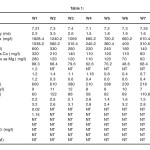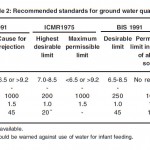Assessment of Ground Water Quality at Municipal Solid Waste Dumping Site-Sewapura, Jaipur
Abhishek Gautam 2 * , Gopal Pathak 1 and Anirudh Sahni 2
1
Department of Environmental Science and Engineering Birla Institute of Technology,
Mesra,
Ranchi
India
2
Birla Institute of Technology,
Mesra,
Ranchi,
Jaipur Campus,
Jaipur
India
DOI: http://dx.doi.org/10.12944/CWE.6.2.12
Copy the following to cite this article:
Gautam A, Pathak G, Sahni A. Assessment of Ground Water Quality at Municipal Solid Waste Dumping Site-Sewapura, Jaipur. Curr World Environ 2011:6;279-282 DOI:http://dx.doi.org/10.12944/CWE.6.2.12
Copy the following to cite this URL:
Gautam A, Pathak G, Sahni A. Assessment of Ground Water Quality at Municipal Solid Waste Dumping Site-Sewapura, Jaipur. Curr World Environ [serial online] 2011;6:279-282. Available from: http://www.cwejournal.org/?p=1409
Download article (pdf) Citation Manager Publish History
Select type of program for download
| Endnote EndNote format (Mac & Win) | |
| Reference Manager Ris format (Win only) | |
| Procite Ris format (Win only) | |
| Medlars Format | |
| RefWorks Format RefWorks format (Mac & Win) | |
| BibTex Format BibTex format (Mac & Win) |
Article Publishing History
| Received: | 2011-09-27 |
|---|---|
| Accepted: | 2011-11-19 |
Introduction
Municipal Solid Waste is a growing menace in present times. Population increase has added the problem many fold. Waste materials or the leachates so formed during the course of time may percolate to the ground water table. This may cause the pollution of ground water and ultimately affects the health of local inhabitants. Leachates are formed by slow decomposition of municipal solid waste. These leachates may run off in the nearby natural water resources such as ponds, lakes and rivers and percolate to ground water causing water pollution (Arneth et.al. 1989). The leachates when mixed with water body increase the concentration of heavy metals, nitrates, sulphates and other organic and inorganic substances. In India more than 60 million population suffer from fluorosis by drinking fluoride contaminated water (Raju et.al. 2009). Though some of the metals like Cu, Fe, Mn, Ni and Zn are essential as micro nutrients for plants and microorganisms, many other metals like Cd, Cr and Pb are proved detrimental beyond a certain limit (Bruins et.al. 2000). Elevated levels of heavy metals lead to toxicity in living organisms (Murugavelh and Vinod, 2010). With sufficient surface water infiltration, soil contaminants such as heavy metals can leach to underlying groundwater. Once the ground water is contaminated it may remain in hazardous state for decades or even centuries. The effects of heavy metals on groundwater are different for different types of soils (Zenglu, 1992). Higher concentration of Zn can cause impairment of growth and reproduction (Nolan, 2003).
Materials and Methods
The present study was carried out at Municipal solid waste dumping site near Jaipur at Sewapura. This MSW dumping site is located at around 20 kms from the Jaipur city. The water samples were collected from 10 different locations namely W1 to W10 (Table-1) surrounding the MSW dumping area. The water samples were collected in well cleaned autoclaved bottles. The samples were then later analysed for physico chemical parameters and heavy metal content. pH determination was carried out by using digital pH meter (Elico). Sulphates, Phosphates, Fluoride and Nitrate were determined by using UV spectrophotometer (Systronic). The heavy metals were analysed by Atomic Absorbtion Spectrophotometer (AAS).
Results and Discussion
The results of physico-chemical analysis obtained for the summer season are given in the table 1.
 |
Table 1: Click here to View table |
The results shows the pH ranges from 7.1 to 7.8 (Table 1). Electrical conductivity (EC) ranged from 1.34 to 3,5 mS. The total dissolved solids were high in range from 610.4 to 1828.4 mg/l. Chlorides from 288.4 to 1038.2 mg/l. Total Hardness from 130 to 600 mg/l. Calcium and magnesium hardness ranged from 60 to 320 mg/l and 60 to 280 mg/l. Sulphates were found in range of 48.6 to 88.3 mg/l. Phosphate was present only at the main dumpsite water sample as 1.2 mg/l. Nitrates was present from 0.4 to 1.6 mg/l. Sodium and potassium ranged from 218 to 600 mg/l and 7 to 15 mg/l. Fluoride was present in the range of 2.4 to 3.2 mg/l. Heavy metals were analysed and their presence was found in traces. Cu and Zn were present in the core MSW dumpsite water sample. The physico-chemical analysis of water samples give varied results. The pH was found in normal limits of W.H.O. and other organisations. The chloride values were in the higher range of acceptable limits given by ICMR, BIS and WHO (Table 2). The nitrates and phosphates were also found in the normal range. The fluoride values are quite high in the study area. The above results are higher than acceptable limits of monitory organisation and indicate the effect of dumping of municipal solid waste in the study area as the ground water quality is slowly deteriorating. The study reveals that the ground water may become completely unfit for the purpose of drinking and irrigation.
The standard values of ground water quality recommended by various organisations are given in table 2.
 |
Table 2: Recommended standards for ground water quality Click here to View table |
Conclusions
It can be thus concluded easily that the dumping of municipal solid waste should completely be stopped in the study area as it is slowly damaging the environment. The leachates formed slowly percolate in the ground water table and may ultimately pollute the ground water. High Chloride and fluoride values in the water samples not only make it unfit for drinking but also cause many diseases. The high values of chloride and fluoride may be due to leaching of toxic substances of municipal solid waste in to the ground water table (Sahni and Gautam, 2009). Chloride conc. if more than 250 mg/l, causes salty taste. Fluoride concentration more 1.5 mg/l if consumed for long period causes dental and skeletal fluorosis (Sahni et.al. 2010). The disease causes complete damage of bones and teeth. The nitrate values are very low. High conc. of nitrate i.e. above 45 mg/l results in “Methmoglobinemia” in infants. Thus the need of the hour is to save water from being polluted by moving away the municipal solid waste dumpsite from the area and develop a properly managed landfill site.
Acknowledgment
Authors are highly thankful to Dr. Abhinav Dinesh, Director, Birla Institute of Technology Mesra, Jaipur campus for his encouragement and guidance.
References
1. APHA, Standard Methods for examination of water and waste water 21st edition 2005 American Public Health Association Washington D.C., (2005).
2. Arneth, J.D., Midle, G., Kerndoff, H. and Schleger, R., “Waste in deposits influence on ground water quality as a tool for waste type and site selection for final storage quality”. Landfill reactions and final Storage quality. Baccini, P. (ed) Springer Verlag Berlin pp.339 (1989).
3. Bruins M R, Kapil S and Oehme F W, Ecotox Environ Safe, 45, 198-207, (2000).
4. Murugavelh S. and Vinodkumar, Removal of Heavy metals from waste water using different biosorbents. Current World Environment 5(2), 299-304,(2010).
5. Nolan, K., Copper toxicity syndrome. Journal of Orthomolecular Psychiatry 12: 270-282, (2003).
6. Raju N. Janardana, Dey Sangita and Das Kaushik, Fluoride contamination in ground waters of sonbhadra district, Uttar Pradesh, India, Current Science, 96(7), 979-985 (2009)
7. Sahni Anirudh., and Gautam Abhishek.,Status of Pre - monsoon ground water quality near Municipal Solid Waste dumping site of Jaipur with respect to Chlorides, Fluorides, Nitrates, (2009).
8. Sahni Kavita., Sahni Anirudh., and Gautam Abhishek., Assessment of Drinking Water Quality of Jaipur Main and its Various Suburb Railway Stations with Special Mention to Fluoride, Current World Environment, 5(2), 293-298, (2010). 9. WHO. Guidelines for Drinking Water Quality. Second Edition. Vol 2 Health Criteria and Other Supporting Information, WHO, Geneva, (1996).
10. Zenglu Xia, Soil environmental capacity of China, Earthquake Publishing, (1992).







